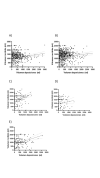[Prevalence of diarrhea in adult patients in intensive care and its relationship with ready-to-use enteral formulas]
- PMID: 36149067
- PMCID: PMC9590831
- DOI: 10.31053/1853.0605.v79.n3.36975
[Prevalence of diarrhea in adult patients in intensive care and its relationship with ready-to-use enteral formulas]
Abstract
Introduction: Diarrhea is a frequent complication in critically ill patients. Its origin is multifactorial. The objective of this work is to analyze the relationship between 5 ready-to-use formulas and the development of diarrhea in critically ill patients.
Methods: Retrospective study where the volume of the stools of 315 patients and the presence of diarrhea defined with a cut-off point of a volume of 250 ml/day were evaluated. 35.34% of the patients presented diarrhea with said cut-off point. The mean volume of stools was 269.20 ml (95% CI: 255.05-283.06).
Results: It was observed that all the formulas analyzed had a slight correlation with the Spearman test between the volume provided and the volume of stools, being: Nutricia Nutrison ® (R: 0.159; P: 0.053), Nutricia Multifibra ® (R: 0.296; <0.001), Nutricia Peptisorb ® (R: 0.323; P<0.001), Nutricia Protison ® (R: 0.108; P<0.001), Fresenius Supportan ® (R: 0.152; P<0.001). Multivariate analysis was performed and it was observed that there were no differences in the incidence of diarrhea between the different enteral formulas during the first 10 days. The change of formulas during hospitalization would be a predisposing factor for diarrhea.
Conclusion: Therefore, the formula and the volume provided are factors that could influence whether patients have diarrhoea. Understanding these possible influences in a deeper way will allow the safest choice of enteral formulas for a patient with diarrhea.
Introducción: La diarrea es una complicación frecuente en los pacientes críticos. Su origen es multifactorial. El objetivo de este trabajo es analizar la relación entre 5 fórmulas listas para usar y el desarrollo de diarrea en pacientes críticos.
Métodos: Estudio retrospectivo donde se evaluó el volumen de las deposiciones de 315 pacientes y la presencia de diarrea definida con un punto de corte con un volumen de 250 ml/día.
Resultados: 35.34% de los pacientes presentaron diarrea con dicho punto de corte. El volumen medio de deposiciones fue de 269.20 ml (IC 95%: 255.05-283.06). Se observó que todas las fórmulas analizadas tenían una correlación leve con la prueba de spearman entre el volumen aportado y el volumen de las deposiciones, siendo: Nutricia Nutrison ® (R: 0.159; P: 0.053), Nutricia Multifibra ® (R: 0.296; <0.001), Nutricia Peptisorb ® (R: 0.323; P<0.001), Nutricia Protison ® (R: 0.108; P<0.001), Fresenius Supportan ® (R: 0.152; P<0.001). Se realizó análisis multivariado y se observó que no hubo diferencias en la incidencia de diarrea entre las distintas fórmulas enterales durante los primeros 10 días. La fibra soluble sería un factor protector en cambio la fibra mixta y semielemental serían factores que aumentan la incidencia de diarrea.
Conclusión: Por lo tanto, la fórmula y el volumen aportado son factores que podrían influenciar en que los pacientes tengan diarrea. Entendiendo estas posibles influencias de una manera mas profunda, permitirá elegir las formulas enterales con mas seguridad para un paciente con diarrea.
Keywords: diarrhea; nutrition, food and diet; critical care outcomes.
Universidad Nacional de Córdoba
Conflict of interest statement
Ninguno.
Figures
Similar articles
-
Impact of a natural versus commercial enteral-feeding on the occurrence of diarrhea in critically ill cardiac surgery patients. A retrospective cohort study.Int J Nurs Stud. 2020 Aug;108:103605. doi: 10.1016/j.ijnurstu.2020.103605. Epub 2020 May 16. Int J Nurs Stud. 2020. PMID: 32502821
-
Prescribing practice and evaluation of appropriateness of enteral nutrition in a university teaching hospital.Ther Clin Risk Manag. 2013;9:37-43. doi: 10.2147/TCRM.S41022. Epub 2013 Feb 7. Ther Clin Risk Manag. 2013. PMID: 23404197 Free PMC article.
-
Diarrhea in Critically Ill Patients: The Role of Enteral Feeding.JPEN J Parenter Enteral Nutr. 2016 Sep;40(7):913-23. doi: 10.1177/0148607116651758. Epub 2016 Jun 6. JPEN J Parenter Enteral Nutr. 2016. PMID: 27271709
-
Diarrhoea in the critically ill.Curr Opin Crit Care. 2015 Apr;21(2):142-53. doi: 10.1097/MCC.0000000000000188. Curr Opin Crit Care. 2015. PMID: 25692805 Review.
-
Use of dietary fibers in enteral nutrition of critically ill patients: a systematic review.Rev Bras Ter Intensiva. 2018 Jul-Sept;30(3):358-365. doi: 10.5935/0103-507X.20180050. Rev Bras Ter Intensiva. 2018. PMID: 30328989 Free PMC article.
Cited by
-
Effects of probiotics in elderly hospitalized tube-fed patients with antibiotics use.BMC Gastroenterol. 2024 Dec 19;24(1):467. doi: 10.1186/s12876-024-03561-9. BMC Gastroenterol. 2024. PMID: 39702125 Free PMC article.
References
-
- McClave SA, Taylor BE, Martindale RG, Warren MM, Johnson DR, Braunschweig C, McCarthy MS, Davanos E, Rice TW, Cresci GA, Gervasio JM, Sacks GS, Roberts PR, Compher C, Society of Critical Care Medicine. American Society for Parenteral and Enteral Nutrition Guidelines for the Provision and Assessment of Nutrition Support Therapy in the Adult Critically Ill Patient: Society of Critical Care Medicine (SCCM) and American Society for Parenteral and Enteral Nutrition (A.S.P.E.N.) JPEN J Parenter Enteral Nutr. 2016 Feb;40(2):159–211. doi: 10.1177/0148607115621863. Erratum in: JPEN J Parenter Enteral Nutr. 2016 Nov;40(8):1200. - DOI - PubMed
-
- Singer P, Blaser AR, Berger MM, Alhazzani W, Calder PC, Casaer MP, Hiesmayr M, Mayer K, Montejo JC, Pichard C, Preiser JC, van Zanten ARH, Oczkowski S, Szczeklik W, Bischoff SC. ESPEN guideline on clinical nutrition in the intensive care unit. Clin Nutr. 2019 Feb;38(1):48–79. doi: 10.1016/j.clnu.2018.08.037. - DOI - PubMed
MeSH terms
LinkOut - more resources
Full Text Sources

